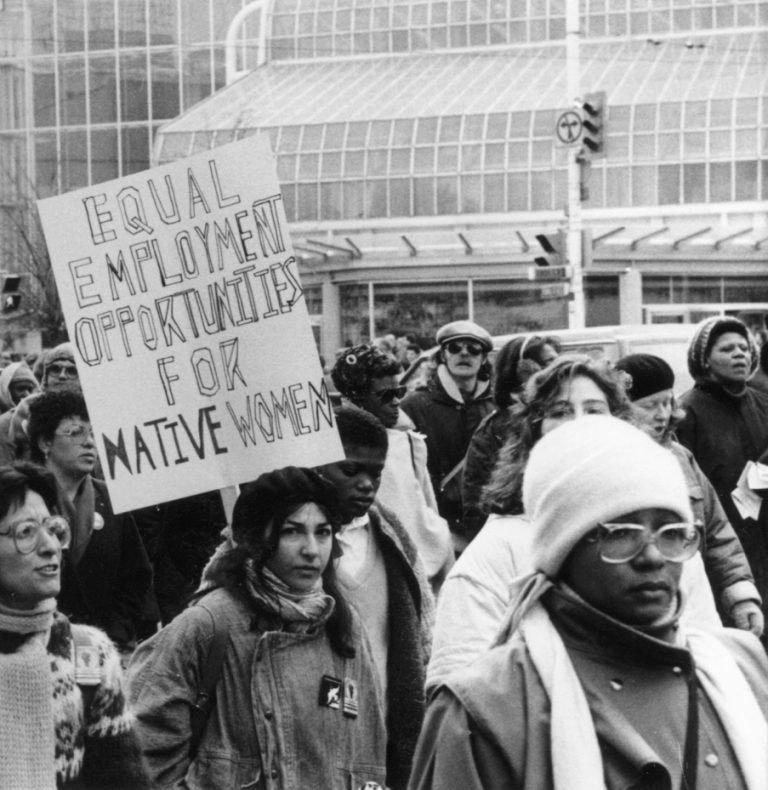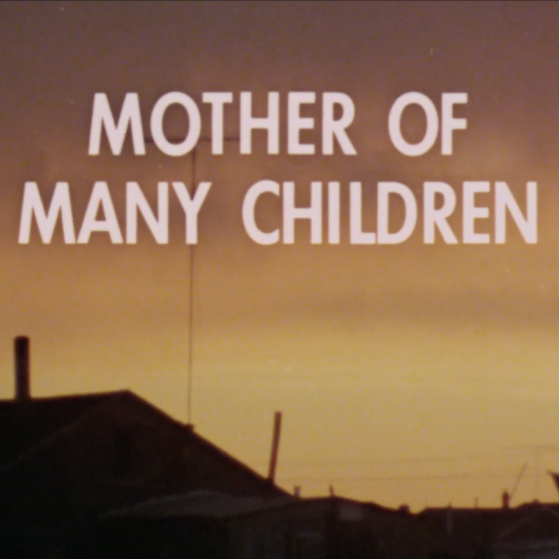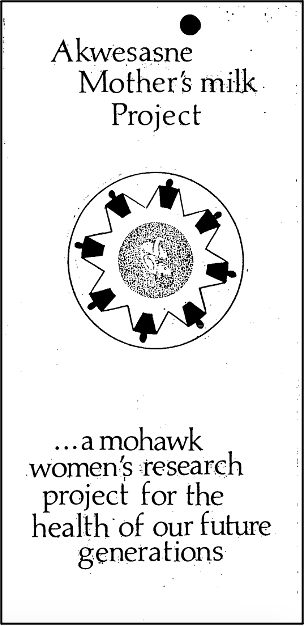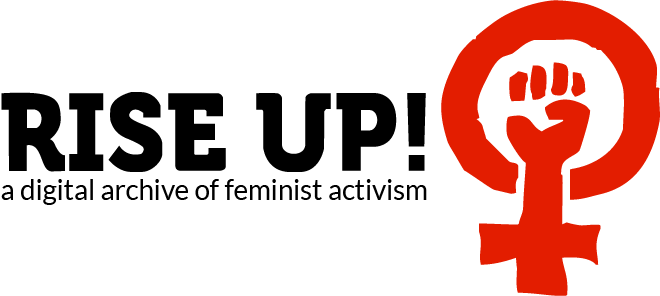By Dr. Jennifer Brant
June is Indigenous History Month. This article is reprinted here with permission from the author, Dr. Jennifer Brant, and Rise Up! a digital archive of feminist activism. This version originally appeared in an April 24, 2024 e-newsletter from Rise Up!
As a Haudenosaunee Mother-Scholar who writes and teaches about Indigenous mothering, Indigenous literatures, and racialized sexualized gender-based violences, I have been covering the topic of Indigenous women’s reproductive injustices for over a decade. It is a theme that comes up in my teaching and writing, and as a mother, community member, and someone who works to call for justice for Indigenous women, families, and communities.
The control and eradication of Indigenous motherhood in Canada is rooted within colonial policies committed to the eugenic eradication of Indigenous people, policies that intervene on Indigenous women’s rights to birth and mother their own children. Today, we see the rippling effect of these moralizing campaigns in the contemporary birthing experiences of Indigenous women, and the continued interference into Indigenous families.

In order to understand reproductive justice for Indigenous women, it is important to understand Canada’s history of eugenics: Eugenics policies in Canada were influenced by early 20th century social Darwinism and were organized around the idea of cleansing and purifying “the social body” to justify the erasure of those deemed to be “other” or threats to that “social body.” And this would occur, in part, through the forced and coerced sterilization of Indigenous women. A brief timeline documents the national push that controlled Indigenous women’s reproductive rights.
The history of eugenics in Canada involved the forced sterilization of Indigenous women.
Under sterilization acts in British Columbia and Alberta, women who were deemed unfit to have children were legally sterilized without their consent and in many cases without their knowledge. There are numerous reports of women who received tubal ligations when they were told they were having their appendix removed. The Alberta sterilization act was in effect from 1928 to 1972 and the British Columbia sterilization act from 1933 to 1973. Other provinces in Canada did not have explicit sterilization acts but equally engaged in the practice of coerced sterilization via tubal ligations. In 2017, Yvonne Boyer and Judith Bartlett released a review of Indigenous women’s experiences of tubal ligation in the Saskatchewan Health Region that documents how forced sterilization still happens in Canada today.

Central to passing Alberta’s 1928 sterilization act was the support of early maternal feminists who are remembered for their roles in securing personhood for women, but that was only for white middle class to elite Christian women. We cannot forget that early suffragettes were strong supporters of compulsory sterilization that significantly targeted Indigenous women who were already held to derogatory stereotypes and judged unfit to birth and mother their own children.
These racist and sexist views against Indigenous women continue to shape maternal health experiences today, and this is evident in recent forced and coerced sterilizations; a concern that must also be understood within the context of racialized, sexualized, and gender-based violences against Indigenous women.
“A nation is not conquered until the hearts of its women are on the ground. Then it is done, no matter how brave its warriors nor how strong its weapons.”
Cheyenne Proverb
When the National Inquiry into Missing and Murdered Indigenous Women and Girls released its Final Report—Reclaiming Power and Place—in June 2019, the report included 231 Calls for Justice that sought immediate action in response to the ongoing travesty of missing and murdered Indigenous women and girls in Canada. As the report documented, this ongoing violence can be understood as a national genocide “perpetrated through the commission of lethal and non-lethal acts.” This genocide has been perpetrated through the ongoing attacks on Indigenous women’s bodies, including their right to physically birth and raise their own children.

Findings from the inquiry document the connections between state sanctioned child removal acts, the residential school system, ongoing child apprehensions, and racialized, sexualized, and gender-based violences. Today, we see the effects of the moralizing campaigns of the 1800s that deemed Indigenous women unfit to raise their own children, and their underlying logics that made coerced and forced sterilization possible. These ideas continue to seep into modern policies that lead to the forced removal of Indigenous children from their families. Dr. Cindy Blackstock has reported that there are more Indigenous children being apprehended from their mothers today than at the height of the residential school system in Canada. For some Indigenous women, forced removal of their children happens immediately following delivery.
Among the Calls to Justice were calls for reproductive justice for Indigenous women such as the elimination of hospital and birth alerts.
Call to Justice 12.8 calls for the end of Birth Alerts:
We call upon provincial and territorial governments and child welfare services for an immediate end to the practice of targeting and apprehending infants (hospital alerts or birth alerts) from Indigenous mothers’ right after they give birth. (National Inquiry into Missing and Murdered Indigenous Women and Girls, 2019).
The troubling practice of birth alerts was ended in most Canadian provinces between 2019 and 2022. As of 2023, Quebec was the only province that had not yet eliminated birth alerts. Birth alerts ended in 2019 in Yukon, British Columbia and Alberta; in 2020 in Manitoba and Ontario; and in 2021 in Saskatchewan, New Brunswick, Newfoundland and Labrador, and Nova Scotia.
The lack of regard for Indigenous women’s bodies and maternal health have occurred and continue to occur in other important ways. Some examples include the distribution of experimental forms of hormonal birth control to Indigenous women before it was medically approved for use, and ongoing and continued exposures to environmental contaminants. For example, Polychlorinated Biphenyls (PCBs) from local factories, often located near Indigenous communities, have resulted in high miscarriage rates and birth defects. In the face of these injustices, Indigenous women have always organized and fought back, and a discussion of Indigenous women’s reproductive injustice is not complete without noting the work of: “The Mother’s Milk Project” – founded by Katsi Cook, a Kanien’kehá:ka midwife. This project responded to the concerns of Akwesasne women who were worried about the reproductive health effects of toxic contaminants that can be found in breast milk. As a midwife, Katsi Cook has been instrumental in supporting the revitalization of Indigenous midwifery, and the spirit of birth involved in holistic understandings of welcoming new life.

Indigenous women’s bodies continue to be sites of surveillance and control, significantly impacting mothers’ roles to pass cultural knowledge to the next generation. The reclamation of Indigenous midwifery supports cultural transmission among the generations as part of a collective call for Indigenous women’s reproductive justice.
To further explore the theme of Indigenous women and reproductive justice, check out the following items from the Rise Up collection:
- Profile of Aboriginal Women in Saskatchewan (1999)
- Pauktuutit Inuit Women’s Association Annual Report 1984-85
- Pauktuutit Inuit Women’s Association Annual Report 1985-86
- “Sterilization and “Adoption”” published in The Other Woman
- Abortion Caravan Demands and Brief (May 1970)
- Vancouver Women’s Caucus Letter – Abortion Strategy (1970)

Comments are closed